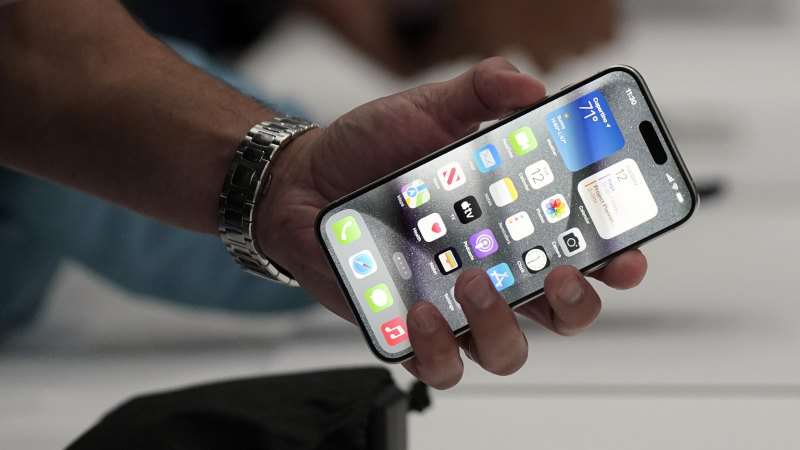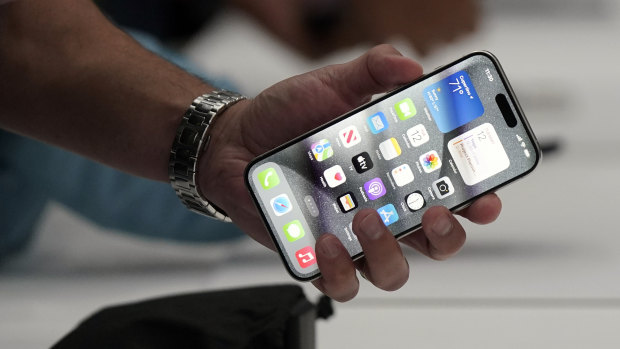Save articles for later
Add articles to your saved list and come back to them any time.
A rush for the new $1500 iPhone, the federal government’s cheap medicines policy and a bout of good gardening weather may have sealed the case for the Reserve Bank to take official interest rates to a 12-year high.
Figures from the Australian Bureau of Statistics on Monday showed the value of retail sales lifted by a much stronger than expected 0.9 per cent in September, led by a big increase in purchases through the nation’s department stores.
Sales of the iPhone 15 contributed to a larger-than-expected lift in the value of retail sales across the country in September.Credit: AP
A series of unrelated one-off events contributed to the result that forced financial markets to sharply shorten the odds of a Melbourne Cup Day interest rate increase, from a coin toss to three-in-four.
According to the bureau, the new iPhone 15 – which was released in the second half of the month – contributed to a 1.5 per cent jump in the value of new household goods. Another factor was the start of Queensland’s Climate Smart Energy Savers Rebate program, which gives residents up to $1000 for the purchase of energy-efficient whitegoods, heat pumps and solar hot water systems.
Sales of medicines jumped as people brought forward their purchases to take advantage of the federal government’s 60-day dispensing program.
The bureau also noted a lift in clothing sales as the warm September contributed to retailers selling early summer season stock. The weather was also a factor in people heading to gardening centres to purchase equipment, mulch and plants.
Warm weather in September tempted Australians into their gardens.Credit: Luke Marsden
The lift in the value of sales does not take into account the impact of inflation, suggesting the total volume of goods sold during September was flat. Population is also strong, with the per capita value of sales over the past three months continuing to edge down.
While September was the strongest month since January, on a smoothed trend basis the past year has been the worst since the bureau started collating retail sales data in 1982.
ANZ economists Madeline Dunk and Adelaide Timbrell said the numbers supported a rate increase by the Reserve Bank next week to take the official cash rate from 4.1 to 4.35 per cent.
But they said the figures did confirm the overall weakness of the retail sector, with the value of sales now just back to where they were in November last year.
“The fact that it has taken 10 months to get back to this level highlights the underlying weakness in the retail sector right now, particularly given the rapid pace of population growth,” they said.
“We expect spending growth will continue to remain soft throughout 2023 but are looking for a lift in 2024 as real household incomes start to grow again.”
Commonwealth Bank economist Stephen Wu cautioned that one-off policy impacts, such as the Queensland rebate and the federal 60-day dispensing change, meant the lift in September may be a pull-forward of planned expenditure that could lead to lower spending in future months.
The head of macroeconomic forecasting at Oxford Economics Australia, Sean Langcake, said retail sales had been resilient to higher interest rates and fast inflation over the past two months.
“The strength in demand over the past couple of months strengthens the case for another interest rate rise,” he said.
“Given the strong inflation print for the September quarter and the hawkish turn in recent RBA communications, we expect to see another rate hike in November.”
Cut through the noise of federal politics with news, views and expert analysis from Jacqueline Maley. Subscribers can sign up to our weekly Inside Politics newsletter here.
Most Viewed in Politics
From our partners
Source: Read Full Article


